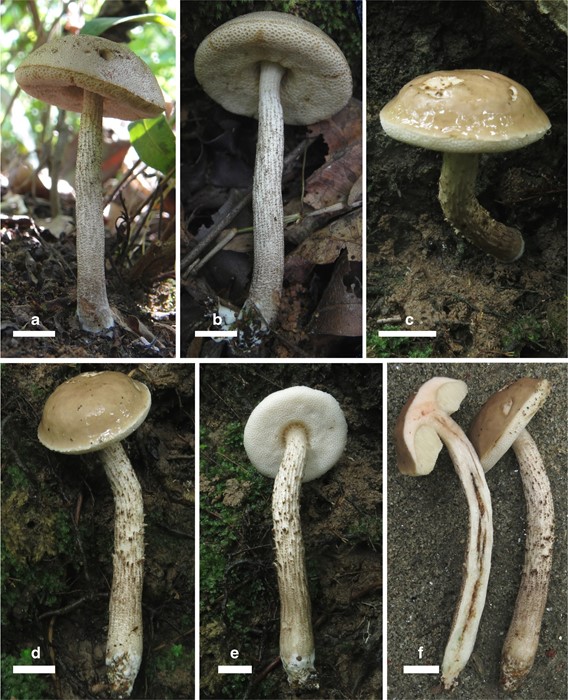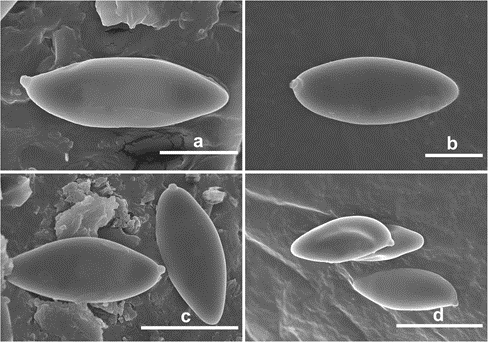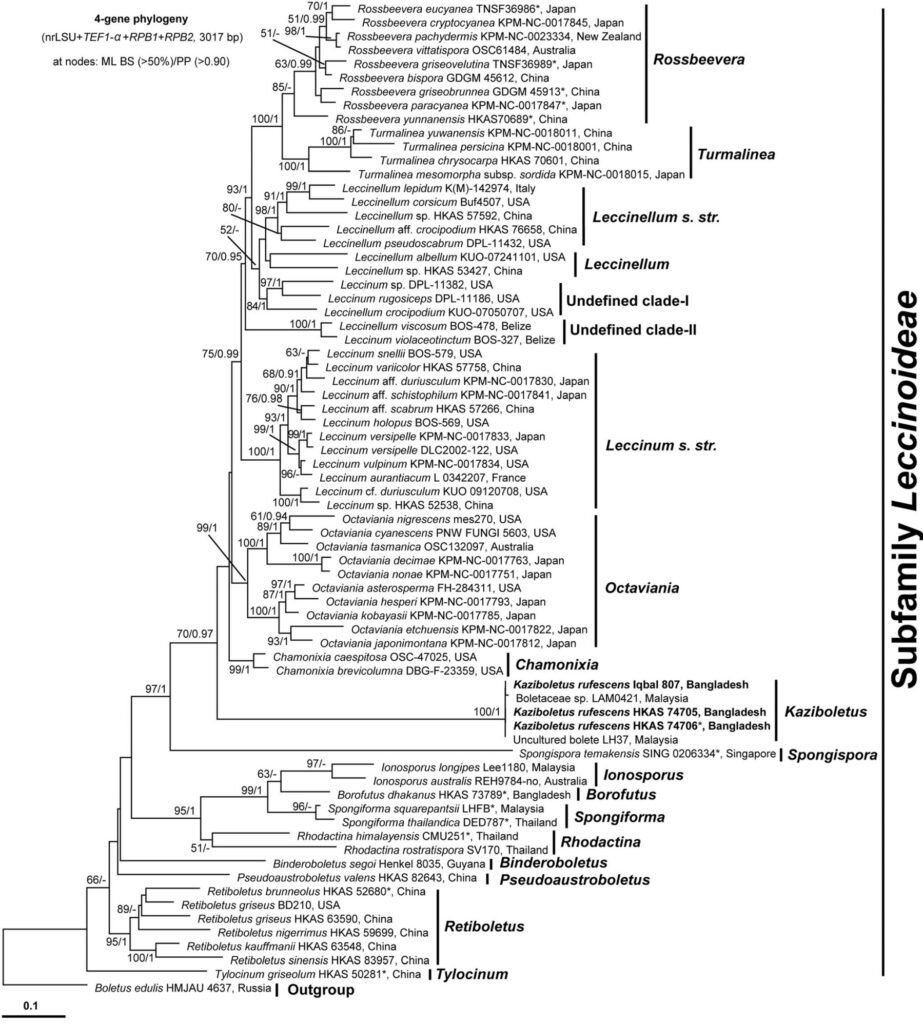Kaziboletus rufescens Iqbal Hosen & Zhu L. Yang, Mycol. Progr. 20(9): 1149 (2021)
MycoBank number: MB 833239; Index Fungorum number: IF 833239; Facesoffungi number: FoF 12583;
Etymology: The epithet “rufescens” (Lat.) refers to the con- text which changes from white to pale red or reddish orange in some patches when exposed.
Typification: Bangladesh: Dhaka division, Gazipur, Bhawal National Park, latitude 24°45’N 90°50’E, elevation 20 m, 29 July 2011, Iqbal 304 (HKAS 74706, holotype; PHI-13, isotype).
Description: Basidiomata small to medium-sized. Pileus 30–60 mm, convex to hemispherical, sometimes with an irregular to wavy margin; surface dry, covered with pale reddish-brown (9D7–8, 9C8) to pale brown (10C7–8) squamules when young, gray to greyish-white (10B1, 10C1) at maturity, brownish-grey when wet, becoming rimose to rugulose with age or during some stage of development; context up to 8 mm thick, solid, white to cream-white, turning slightly pale red (8A4–5) to pale reddish-orange (7A6–7) in some patches on exposure. Hymenophore tubulose, free, depressed around the stipe, white to creamy white, turning slightly brown when injured; tubes 7–10 mm long, pores angular or round up to 1 mm broad. Stipe 40–75 × 8–12 mm, central, cylindrical, attenuated upwards, scabrous, covered with reddish-brown (when young) to grey-brown (at maturity) squamules; conspicuous longitudinal striations present with fine cross lines from the apex to just above the base, the ridges somewhat anastomosing, sometimes sub-reticulate at the apex, the basal half more scabrous than the upper half; context 8 mm thick, solid, white to dull white, staining pale red to reddish-orange in some patches, pale blue at stipe base in one specimen (Iqbal 807). Basal mycelium white. Odor and taste not distinctive. Basidiospores [60/3/3] (15–)17–19(–21) × 5.5–6.5(–7) μm, elongated to cylindro-fusoid, thin-walled, inamyloid, smooth under light microscope and SEM, pale yellow (1A2–3) to vivid yellow (2A6–8) in H2O and 5% KOH. Basidia 30–36 (–45) × (9–)10–12 μm, narrowly clavate, clavate or broadly clavate, colorless in H2O and 5% KOH, thin-walled, 4-spored, occasionally 2- or 3-spored; sterigmata up to 3.5 μm long. Hymenophoral trama 100–130 μm wide, boletoid, hyphae cylindrical, 4–10 μm wide, hyaline. Cheilo- and pleurocystidia 50–70 × 10–15 μm, scattered, not abundant, fusoid to subfusoid, mucronate, somewhat lanceolate, hyaline, thin-walled, smooth, without encrustation. Pileipellis an epithelium, 100–130 μm thick, consisting of 2–3(–5) broadly clavate to pyri- form to broadly ellipsoid inflated cells in chains; terminal cells 15–30 (–50) × 10–16 (–20) μm, with yellowish-brown to brown vacuolar pigments; sometimes mixed with filamentous hyphae 3–5 μm wide, with brown vacuolar pigments. Stipe trama composed of parallel, cylindrical, hyaline hyphae up to 13 μm wide. Stipitipellis covered by a hymenium-like structure, composed of clavate to broadly clavate caulocystidia 16–35 × 6–11 μm, with yellowish brown to pale brown vacuolar pigmentation. Clamp connections absent in all tissues.
Habit and habitat: Mostly solitary in pure stands of S. robusta, and putatively forming ectomycorrhizae with S. robusta.
Known distribution: Currently known only from tropical Bangladesh, and possibly Malaysia (based on sequence data).
Additional specimens examined: Bangladesh. Dhaka division: Gazipur, Bhawal National Park, elevation 20 m, 5 Jul 2011, Iqbal 154 (HKAS 74705). Rangpur division: Dinajpur, Birol, Kaliganj Sal Baghan, elevation 60–70 m, 7 Aug 2013, Iqbal 807 (PHI-14).
GenBank Accession Numbers: HKAS 74705 – nrLSU: JQ928620, TEF1-α: JQ928579, RPB1: JQ928589, RPB2: JQ928599; HKAS 74706 – nrLSU: JQ928618, TEF1-α: JQ928578, RPB1: JQ928588, RPB2: JQ928600.

Fig. 1 Basidiomata of Kaziboletus rufescens. a, b HKAS 74706, holotype; PHI-13, isotype; c, d, f PHI-14. Bars = 1 cm

Fig. 2 Microscopic features of Kaziboletus rufescens (HKAS 74706). a Basidia with basidioles; b Basidiospores; c Hymenial cystidia (Cheilo- and pleurocystidia); d Epithelium pileipellis; e Caulocystidia

Fig. 3 SEM of smooth basidiospores of Kaziboletus rufescens (a–d HKAS 74706, holotype). Bars = a, b 5 μm. c, d 10 μm

Fig. 4 Phylogenetic relationships of the genera of subfamily Leccinoideae inferred from 4-gene (nrLSU, TEF1-α, RPB1, and RPB2) dataset of 72 samples of Boletaceae using maximum likelihood (ML). Bootstrap (BS) values derived from ML (BS > 50%) and posterior probabilities (PP) from Bayesian Inference (BI) (PP = 0.90) analyses are shown above or beneath the branches at nodes. Kaziboletus rufescens gen. et sp. nov. is highlighted in bold. The voucher specimen number for each species is provided after the species name followed by the country name. An asterisk next to the voucher specimen number indicates holo- type material.
